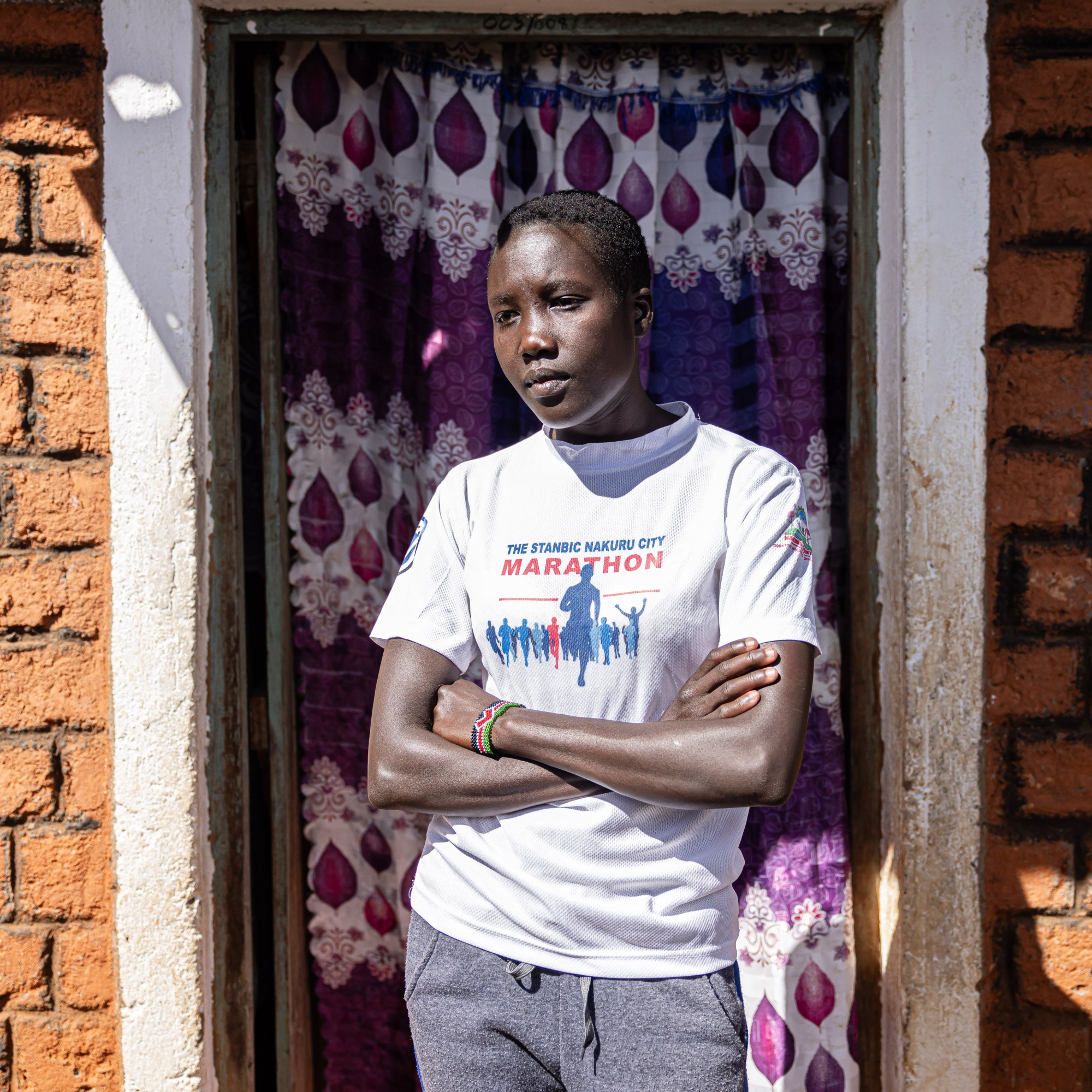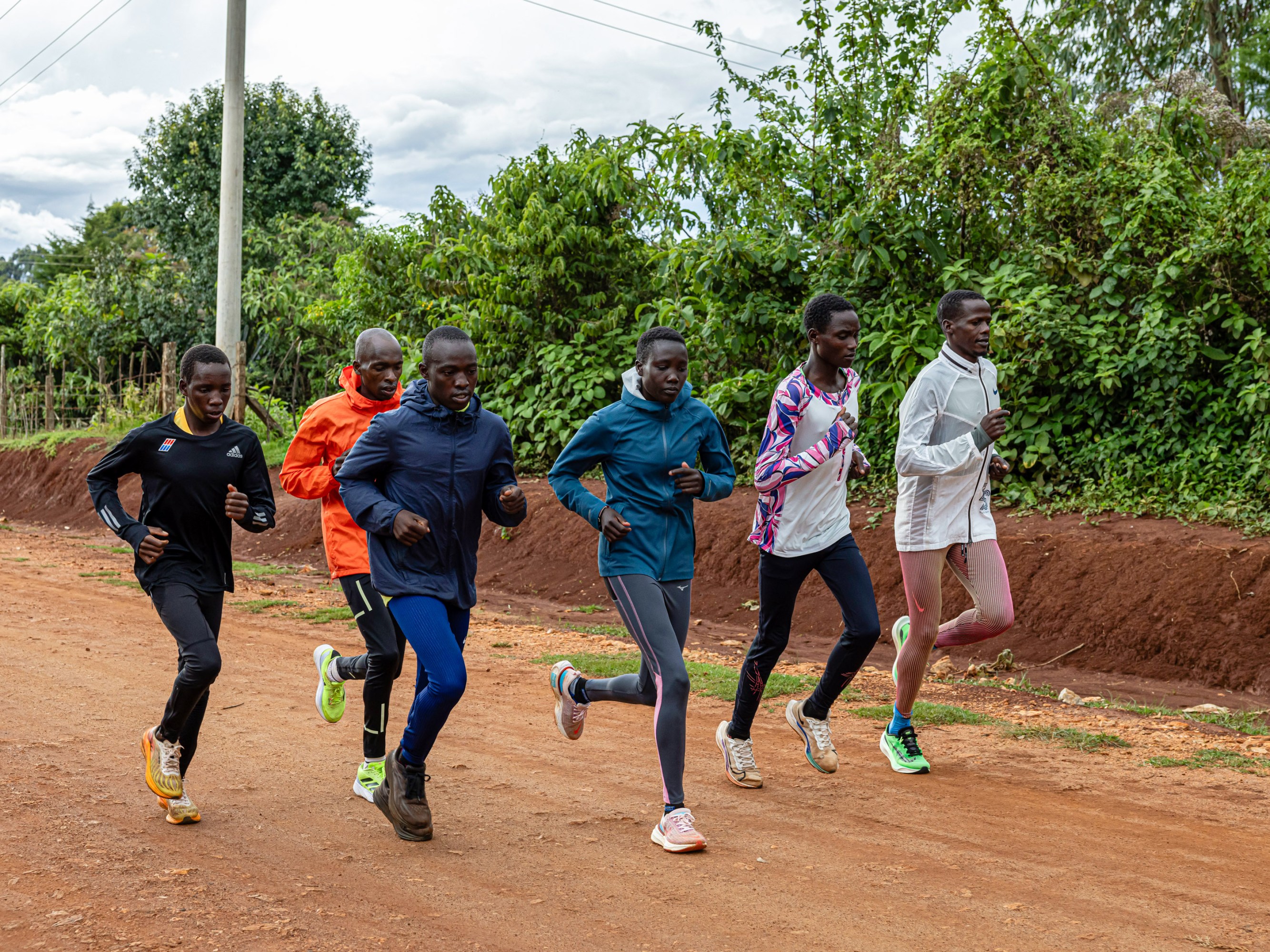Many credit the shoes with keeping runners healthy. David Kirui, a physiotherapist who’s treated many of Kenya’s top marathoners, estimates that overuse-related injuries, like stress fractures, Achilles tendinitis, and iliotibial band syndrome, are down at least 25%. Several veteran runners tell me the shoes have helped extend their careers, and therefore their earning power. “In the old shoes, after 10 marathons you’d be completely exhausted,” says Jonathan Maiyo, who’s been an elite road racer since 2007. “Now 10 marathons are like nothing.”
Who benefits?
Runners like those in Berardelli’s group are a chosen few. The majority of athletes training in Kenya have never made any money from the sport; many run in secondhand shoes gifted by friends or purchased in local markets, and few can afford supershoes of their own. One day in Iten, a small town north of Eldoret that clings to the edge of the Rift Valley escarpment, I meet Daisy Kandie, a 23-year-old who moved here after high school and is among the hundreds of aspiring pros who toil along the town’s clay roads each morning. Her goal is the same as most: get noticed by an agent, most likely a foreigner, who’ll provide gear, arrange races outside the country, and in some cases negotiate a contract with a shoe company.
Among Iten’s legion of dreamers, Kandie is luckier than most: her parents see her as a future breadwinner, so they’ve supported her quest, and even sold a plot of farmland so they could buy her a pair of neon-green-and-pink Nike Alphaflys. The shoes were cheaper in Iten—approximately $180—than they would have been in the US; it’s an open secret that some runners with sponsorships sell shoes they get for free to local shops, which resell them at below-market prices. That money, nonetheless, represents a lot of sacrifice: Kandie pays roughly that amount for a year’s worth of rent on the small room she keeps at the edge of town. The cost of the shoes, which she refers to as her “Sub-2” for the idea of a below-two-hour marathon, doesn’t make her resentful. Instead, she says, having the latest gear helps keep her motivated. Still, while she uses them only for fast runs twice a week, as well as in occasional local races, their soles have considerable wear, and she doesn’t have a plan for a replacement.
“By then I’ll have gone,” she said, referring to racing outside Kenya, when I asked what she’ll do for her next pair. “I have hopes.”

PATRICK MEINHARDT
Although supershoe technology has raised the cost of doing business for Kandie and others like her, it’s most controversial for its role in skewing results at the very top. Hoogkamer’s landmark study of the Vaporfly, which found that the shoes improved running economy by 4% on average, also found that the benefit ranged from roughly 2% to 6% depending on the athlete.
Subsequent research involving other supershoes has documented a similar range of responses. One 2023 study by Adidas-affiliated researchers, which tested seven elite Kenyans in three carbon-fiber prototypes and a traditional racing flat, recorded a runner using 11% less energy in one shoe and a runner using 11% more energy in another. Melanie Knopp, the study’s lead author, cautions that each athlete was tested in each shoe only once, and that some of the subjects were unfamiliar with running on a treadmill. Nonetheless, researchers generally agree that individual athletes “respond” to some shoes better than others. Why isn’t entirely clear: Hoogkamer estimates there may be 20 variables at play, including weight, foot length, calf muscle strength, and whether the runner strikes the ground with the forefoot, midfoot, or heel. Shoe geometry matters as well. Abdi Nageeye, a Dutch marathoner who trains in Iten and finished second to Kipchoge at the Tokyo Olympics, says he struggled with the first two versions of Nike’s Alphafly; as a 120-pound heel-striker, it forced him to “skip” in a way that felt unnatural. He says the newest Alphafly model, which has a greater drop in “stack height”—or foam thickness—from heel to toe, is a much better fit.
“If everybody is in their ideal shoe, are there still some people who’ll get more benefit than others? The answer is probably yes.”
Dustin Joubert, a supershoe expert and professor of kinesiology at St. Edward’s University in Austin, Texas
What all this means for the marathon’s integrity is a hotly debated topic. Today, many pro runners in the West undergo treadmill-based metabolic tests to determine which shoe works best, and in some cases which company to sign with. That’s less common in Kenya, where greater competition leaves athletes less room to negotiate. Among runners I spoke with, most of those with shoe contracts said their sponsor has a model they like, but it’s difficult to know if it’s their absolute best fit. Even if it is, some suspect that certain runners are better suited to the supershoe technology more broadly. “If everybody is in their ideal shoe, are there still some people who’ll get more benefit than others?” asks Dustin Joubert, a supershoe expert and professor of kinesiology at St. Edward’s University in Austin, Texas. “The answer is probably yes.”

PATRICK MEINHARDT
Despite the benefits his runners gain in training, Berardelli says the shoes have introduced “question marks”: in a marathon today, he says, it’s less clear than ever whether the winner is indeed the runner who’s the strongest or has the smartest racing tactics. Stephen Cherono, a Kenyan who competed for Qatar as Saif Saaeed Shaheen and held the world record in the 3,000-meter steeplechase from 2004 until it was broken with the aid of superspikes last year, believes World Athletics should have placed greater restrictions on the technology before it was too late: although the global body maintains limits on sole thickness and prohibits the use of shoes that aren’t made available for sale, these guidelines are meant to help steer innovation, not squelch it. Cherono tells me he’s a big fan of Formula 1, the global motor sport, but worries that running, in its focus on performance engineering, is becoming too much like it. “Too often the conversation is now about the shoe and not the person wearing it,” he says.

